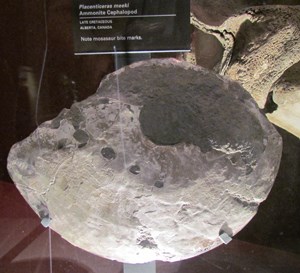Part of a series of articles titled National Fossil Day Logo and Artwork – Prehistoric Life Illustrated.
Article
Fossils of the 2011 National Fossil Day Artwork


Image courtesy of the Smithsonian Institution, National Museum of Natural History.

NPS photo of Smithsonian National Museum of Natural History specimen.
Fossil Facts:
- Mosasaurs are reptiles, but were not dinosaurs.
- Ammonites are members of a class of organisms known as cephalopods, meaning "head-foot". This group also includes the modern octopus.
- Mosasaurs ranged in size from about 11 to 57 feet long, while ammonites could vary in size from an inch or two to 6 feet in diameter!
- Ammonite shells increased in size and complexity through time, perhaps contributing to their extinction at the end of the Mesozoic.
Word origins:
- Mosasaur: mosa refers to the Meuse River in Holland, where the type specimen was found. sauros is Greek for "reptile".
- Ammonite: Early scientists referred to ammonites as ammonis cornua, meaning "Ammon's horn", referring to the Egyptian god Ammon. Ammon was commonly depicted with ram's horns, which are coiled like ammonites' shells.
Go See Them!
Ammonites are quite common in the fossil record and can be found in a number of locations across the country. Some National Park units where ammonite fossils have been found include Dinosaur, Carlsbad Caverns, Glacier, Glen Canyon, Grand Teton, Guadalupe Mountains, Mesa Verde, Niobrara, Yukon-Charley Rivers, and Zion, among others.
Mosasaurs have been found throughout the Great Plains region, including at partner sites Ladonia Fossil Park, Yellowstone National Park, and Mesa Verde. They also reside in the collections or exhibits of the Fick Museum, Kansas University Museum of Natural History, Museum of the Rockies, Sternberg Museum, South Dakota School of Mines Museum of Geology, Tate Museum, Texas Natural Science Center at the Texas Memorial Museum. Most of the states where these museums are located would have been covered by the Cretaceous Interior Seaway and thus, would have been home to these aquatic beasts. For more information on these partners, click on their links from our Partners tab.
Last updated: September 8, 2020
